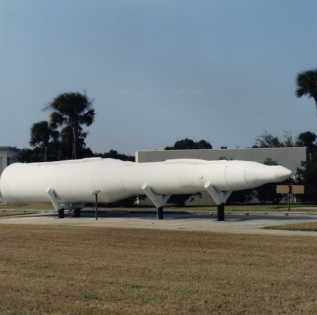
Overview
Retired Exhibit
Type: Inter-Continental Ballistic Missile (ICBM)
Designation: HSM-80/LGM-30
Payload: Nuclear warhead
Agency: U.S. Air Force
Contractor: The Boeing Company
Cape Canaveral Air Force Station Operations: 1961-1964
History
Named after the Revolutionary War soldier who could “reload and fire a shot in less than a minute”, Minuteman I represented the first generation of U.S. Air Force missiles that could be launched at the touch of a button.
Studies which led to the Minuteman missile began in 1956. While development of the U.S. Army Jupiter and the U.S. Air Force Thor Intermediated Range Ballistic Missiles (IRBM) were already underway, the military sought to deploy a solid-fueled, land based IRBM. The use of exclusively solid-fueled stages would allow a missile to be safely stored for long periods of time. A solid-fueled missile would require no fueling prior to launch and could be safely housed in underground silos, providing a great tactical advantage over existing liquid-fueled IRBM technology.
Minuteman Origins
Although both Jupiter and Thor would become potent weapons in the U.S. arsenal, their liquid-fueled engines made them quite labor-intense in the field. As a result, in 1958 the Boeing Aerospace Company was contracted to develop the Minuteman. It was soon discovered that the basic, three-stage version of the Minuteman could have a range of over 6,000 miles. The Minuteman was subsequently re-designated as an Intercontinental Ballistic Missile (ICBM).
The first generation of the Minuteman was deployed under the LGGM-30A designation, with an improved version designated LGM-30B. These missiles are more commonly referred to as the Minuteman I.
The Minuteman I first stage engine employed a Thiokol engine which burned PBAA polymer binder, AP oxidant and aluminum powder, producing a thrust of 200,000 pounds at liftoff. An Aerojet-General second stage engine burned PU/AP fuel and provided a 60,000 pound thrust. A Hercules third stage engine burned Ne/Ng/AP fuel and produced a thrust of 35,000 pounds. All three stages were housed within a steel frame, although certain frame sections were later replaced with titanium. Each stage employed gimbaled exhaust nozzles. This marked the first time gimbaled exhaust nozzles were used on solid-fueled engines.
The Minuteman I was controlled by an Autonetics, inertial guidance system. An advanced design in its day, the Autonetics system was the first to employ solid state technology, sub-miniature digital computer hardware and integrated circuit microelectronics. The Minuteman I was initially designed to be launched from a mobile railway system as well as underground silos. The railway option was abandoned prior to actual Minuteman I testing and deployment.
Mission Failure
The first full-silo Minuteman I launch attempt from Cape Canaveral occurred in 1961. The missile blew up in the silo, creating one of the most memorable and spectacular failures in the history of the Cape.